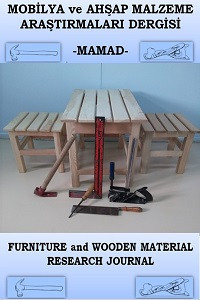Mobilya endüstrisi atıklarının polimer kompozit üretiminde değerlendirilmesi
Bu çalışmada, PVC polimer matrisi ile mobilya endüstrisi atıklarından orta yoğunluklu lif levha (MDF) ve masif kereste atıkları kullanılarak kompozit malzemeler üretilmiştir. Kompozit malzemelerin üretimi için her bir atık malzeme PVC polimeri ile çift vidalı bir ekstruder ve peletleyici kullanılarak pelet haline getirilmiştir. Elde edilen pelletler, sıcak pres kalıplama tekniği ile 250x250x2 mm boyutlarında kompozit levhalar haline getirilmiştir. Kompozitlerin çeşitli uygulamalarda kullanılıp kullanılamayacaklarını belirlemek için yapılan testler ile elde edilen kompozitlerin birbirleriyle ve saf PVC ile mekanik özellikleri karşılaştırılmıştır. Mekanik testlerin sonucu %10 odun unu katkılı PVC kompozitlerin çekme mukavemeti değerinin 24.51 MPa ile en yüksek çekme dayanım değerine sahip olduğunu göstermiştir. Öte yandan en yüksek eğilme direnci değeri, %10 MDF tozu katkılı kompozit malzemede 61.20 MPa bulunmuştur.
Anahtar Kelimeler:
Mobilya endüstrisi atıkları, kompozit malzeme, PVC, MDF, mekanik özellikler
Evaluation of furniture industry wastes in polymer composite production
In this study, composite materials were produced by adding medium density fiberboard (MDF) waste and massive timber waste from furniture industry into PVC polymer matrix at different ratios. For the production of PVC composite materials, each waste material was mixed with PVC polymer and then, they were converted into pellets using twin screw extruder and combined pelletizer. The obtained pellets were molded into composite boards in 250 x 250 x 2 mm dimensions via hot press molding technique. The mechanical properties of the produced composites were compared with each other and with pure PVC based board in order to determine whether they can be used in various applications. The result of the mechanical tests showed that the tensile strength value of 10% wood flour-added PVC composites had the highest tensile strength value of 24.51 MPa. On the other hand, the highest bending strength value of 61.20 MPa was found for composite material with 10% MDF powder.
Keywords:
Furniture industry wastes, composite material, PVC, MDF,
___
- ASTM, D. 638. (2001), Standard test methods for tensile properties of plastics, American Society for Testing and Materials, West Conshohocken, PA.
- ASTM, D. 790. (2003), Standard test methods for flexural properties of unreinforced and reinforced plastics and electrical insulating materials, American Society for Testing and Materials, West Conshohocken, PA.
- ASTM, D. 256. (2005), Standard test methods for impact resistance of plastics and electrical insulating materials, American Society for Testing and Materials, West Conshohocken, PA.
- ASTM. D. 4703-10. (2010), Standard practice for compression molding thermoplastic materials into test specimens, plaques, or sheets, American Society for Testing and Materials, West Conshohocken, PA.
- Bromhead, A. (2003), Reducing wood waste in furniture manufacture, Fauna & Flora International, Cambridge, UK.
- Caulfield, D.F., Clemons, C., Jacobson, R.E. and Rowell, R.M. (2005), Wood thermoplastic composites, handbook of wood chemistry and wood composites, Rowell, R.M. (Ed.), Boca Raton, FL: CRC Press, USA.
- Chaharsoughi, M.A., Najafi, S.K. and Behrooz, R. (2018), Formaldehyde emission from PVC–wood composites containing MDF sanding dust, J Vinyl Addit Technol, doi:10.1002/vnl.21637
- Iulianelli, G., Tavares, M.B. and Luetkmeyer, L. (2010), Water absorption behavior and impact strength of PVC/wood flour composites, Chemistry & Chemical Technology, 4 (3), 225-229.
- Klyosov, A.A. (2007), Wood-plastic composites, John Wiley & Sons, Inc., Hoboken, New Jersey, 720s.
- Schwarzkopf, M.J. and Burnard, M.D. (2016), Wood-plastic composites-performance and environmental impacts, Environmental impacts of traditional and innovative forest-based bioproducts, Springer, pp. 19-43.
- Sofuoğlu, S.D. ve Kurtoğlu, A. (2006), Masif ağaç malzemenin işlenmesinde fire oranları, Dumlupınar Üniversitesi Fen Bilimleri Enstitüsü Dergisi, 11, 189-204.
- Sombatsompop, N., Chaochanchaikul, K., Phromchirasuk, C. and Thongsang, S. (2003), Effect of wood sawdust content on rheological and structural changes, and thermo‐mechanical properties of PVC/sawdust composites, Polymer international, 52(12), 1847-1855.
- Yayın Aralığı: Yılda 2 Sayı
- Başlangıç: 2018
- Yayıncı: Bekir Cihad BAL
Sayıdaki Diğer Makaleler
Bekir Cihad BAL, Elif AKÇAKAYA
Mobilya endüstrisi atıklarının polimer kompozit üretiminde değerlendirilmesi
Nasır NARLIOĞLU, Tufan SALAN, Nihat Sami ÇETİN, Mehmet Hakkı ALMA
Odunun yoğunluğu ile mekanik özellikleri arasındaki ilişkinin belirlenmesi üzerine bir araştırma
Bekir Cihad BAL, İbrahim BEKTAŞ
Manolya ağacı, akçaağaç ve tespih ağacı odunlarında vida tutma direnci üzerine bir araştırma
Ahşap ve mimarlık eğitimi: İstanbul örneği
Yonga levha üretiminde pirinç kavuzu kullanımının yüzey pürüzlülüğü üzerine etkisi
